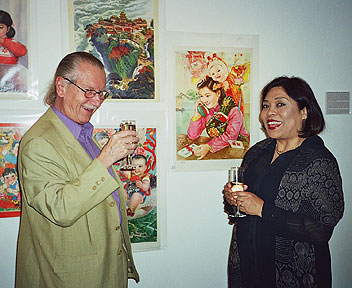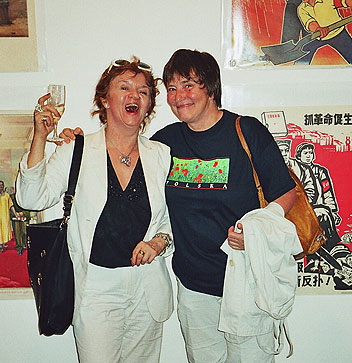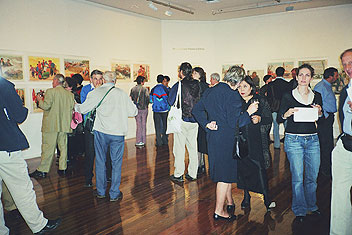Sigurdson Poster Collection Moves to Australia
Sigurdson has decided to make his collection available for display in various parts of the world. Thus, a first exhibition Modernization in China Viewed through Political Posters became available to viewers in Canberra on 7 October 2004 at the Drill Hall Gallery of The Australian National University (ANU). Sigurdson was during autumn 2004 invited as Visiting Fellow at the Humanities Research Centre (HRC) at the ANU from the beginning of October.
While at HRC Sigurdson on October 15 gave a lecture on Political Chinese Passions, the theme of the exhibition, followed by an official viewing at the Drill Hall Gallery where 65 posters were hanging until November 7. The event is illustrated by four photographs that were taken by Basia Meder.
China Over 20 Years
The pictures hanging on the walls cover a period of little more than 20 years - from the Great Leap Forward in the late 1950s to the Open-Door-Policy that started in 1978 and beyond into the early 1980s. The selected posters covered three main political phases. A first stage is recovery after the Great Leap Forward in 1958-59 which set the stage for Mao’s attempt to recover total leadership over China’s modernization. A second stage of China’s self-reliance partly overlaps with the first – as the Cultural Revolution still continued. The third stage is a revival period that has become known as the Open-Door-Policy, when China’s economic policies were to drastically change – away from self-reliance into integration with a global economy.
A last poster in the exhibition is from 1983 and contains a number of significant symbols. First, the picture shows a lady with a child on her back and illustrates the one-child-family policy that had started a few years earlier. Second, dresses of both mother and child show rich decorations, and together with the lantern, indicate patterns that are distinctly traditional Chinese in character. Third, the lady with the child is inside a bank to deposit money – a pile of banknotes is lying in front of her. The title of the poster is “Rich People – Strong Country”.
Humanities Research Centre
The invitation to Humanities Research Centre (HRC) and to arrange the poster exhibition in Canberra provided a number of unforeseen rewards. First of all the stay in Canberra provided an opportunity to meet and interact with researchers in cultural and cultural-relations fields that proved to be extremely stimulating for a person with an earlier focused interest in economics and engineering. Second, the lecture and the exhibition opened up contacts with museum curators, Chinese poster artists and local collectors of Chinese posters. Third, the preparation of the poster exhibition, by an act of serendipity, produced direct contacts with Professor Zhang Xianchang, the director of the Popular Art Centre at Liaocheng University in Shandong province. The research period at HRC and the accompanying exhibition will result in an article with the tentative title “Symbols in Chinese Political Posters”.

Jon Sigurdson is finishing introduction by pointing to poster of Lady Customer inside Bank with title “Rich People — Strong Country” (canberra01)

Jon Sigurdson toasts Mme Nancy Sever, Director of the Drill Hall Gallery at The Australian National University (canberra02)

Dr Krystyna Palonka, co-organizer of the exbition chats with Basia Meder — exhibition photographer. (canberra03)

A first exhibition viewing on October 15 attracted a number of visitors from inside and outside the Australian National University. (canberra04)
